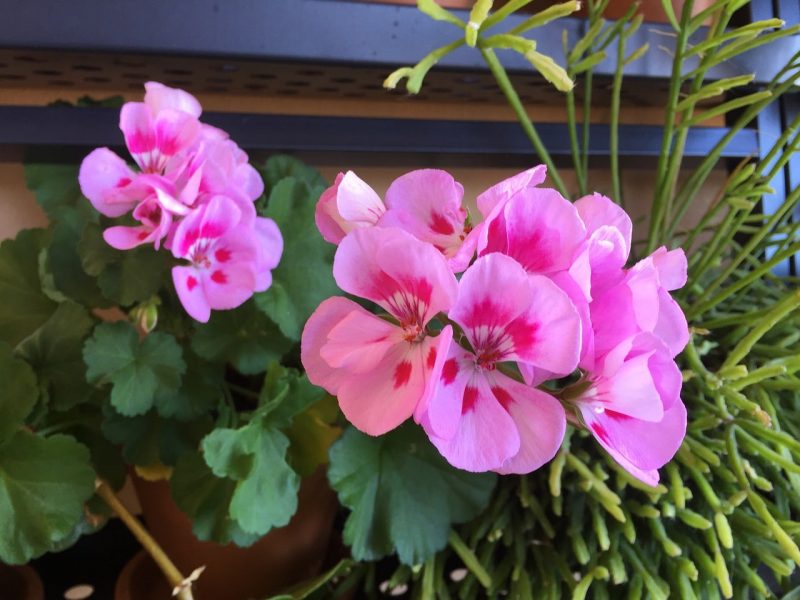Taking notes on how to fertilize geraniums is crucial to ensure beautiful booms, so mark your calendar to do it every two weeks in the growing season. Fertilizing geranium will help prevent stunted or yellowing plants, making them one of the annuals that do well with feeding. This is also why working four inches of organic matter into the soil when planting is ideal.
The University of Massachusetts Amherst even recommends constant fertilization. With these feeding facts and recommendations in mind, you should have thriving and beautiful geraniums either indoors or outdoors. However, you can always play it safe and use the greenhouse if you’re rooting geraniums.

Remember that these plants will respond well to these techniques if they are in an ideal environment with their preferred conditions.
How To Fertilize Geraniums: What To Consider
Timing
Clemson University recommends fertilizing new flowerbeds and during the growing season. As mentioned earlier, the University of Massachusetts Amherst also said the benefits of constant fertilization. But what are the specific timings for these instances?
You can work the fertilizer in the flowerbeds upon planting or early in spring. And during the growing season, the geraniums will respond well with feeding every two weeks or four to six weeks when they are actively growing. You can also feed outdoor geraniums when your area experiences heavy rains because nitrogen can leach at this condition.
On the contrary, you don’t need to fertilize new indoor geraniums immediately. Instead, feed when they have established themselves and do so every four weeks in spring and summer. You can also fertilize indoor geraniums in the fall and winter every eight weeks, but dormant plants won’t require feeding.
When should you not fertilize geraniums? For starters, be careful not to overfertilize the plants, especially outdoor geraniums. They can cease to bloom, and they might need some time to rest with only water.
Type of fertilizer
It’s not enough to mark your calendar on the recommended timings for fertilizing geraniums. For example, a typical fertilizer for new flowerbeds is a 10-20-10 fertilizer per 100 square feet. During the growing season, when they’re active, water-soluble fertilizer at half strength should suffice.
You can then use the same fertilizer for follow-up feedings. Sticking with these recommendations will prevent overfertilizing and problems in nutrients that can negatively affect geraniums. Then, the conditions as the guide on what fertilizer to use to avoid drawbacks.
For example, nitrogen leaching is expected during the rainy season. With this in mind, you can make sure that you’ll meet the outdoor geraniums’ nitrogen needs by feeding them with a 5-10-5 dry fertilizer. On the other hand, indoor geraniums in pots will have a different fertilizer requirement than those mentioned.
Potted geraniums use a mix of soil, sand, and peat as a medium, and will need fertilizing once they’re established after two to three months. At this point, you can use two tablespoons of 20-20-20 water-soluble fertilizer to one gallon of water. Speaking of water-soluble fertilizer, this is also the best type for constant feeding of 200 to 250 ppm of nitrogen.
Application
Once you know the timing and types of fertilizer that work well with geraniums, the proper application will be the last crucial factor to success. For example, constant fertilization prevents nutrient problems, but overfertilization will also cause blooming and growth drawbacks. How does one avoid these problems?
If you’re using a water-soluble fertilizer, you can assume that you need to ensure an adequate amount of water and drainage as well. This way, water can drain through the medium or soil every time you water geraniums and prevent salt buildup. Remember that a medium with high salt content will negatively affect any plant.
You can also prevent this in the greenhouse by using sub-irrigation when you do liquid feeding of 150 to 200 ppm of nitrogen. You can then comfortably monitor the pH and salt levels in the medium. Once the geraniums undergo dormancy in winter, stop feeding to prevent the roots from drying.
More so, avoid fertilizing outdoor geraniums when it’s scorching since the fertilizer can dry and burn the plants. Lastly, use fertilizer at half the original rate when you make a second application upon planting outdoor geraniums.
Signs Of Nutrient Deficiencies In Geraniums
The most common symptoms of nitrogen deficiency are delay in growth, stunting, and yellow leaves. This is likely when the gardener doesn’t use a well-decomposed amendment on the soil since it will decay upon application and rob the soil of nitrogen. On the contrary, the plant can have red-purple lower leaves, weak stalks, and stems, leading to necrosis and death if they need potassium.
Conclusion
Geraniums are one of those plants that respond well to feeding. But to avoid problems in deficiencies and overfeeding, you must know how to fertilize geraniums properly. Start first by learning about the timing, type of fertilizer, and proper application.
In general, you can work the fertilizer on the soil of outdoor geraniums upon planting. On the other hand, you should only fertilize indoor geraniums once they have established themselves. Afterward, feed every two weeks while the plants are actively growing with a water-soluble fertilizer.
And while geraniums benefit from constant fertilizing to avoid deficiencies, make sure that you are also watering them adequately. This will drain excess salts and prevent problems in growth later on.
